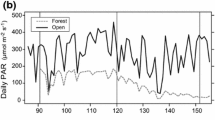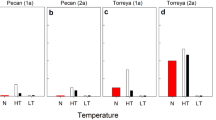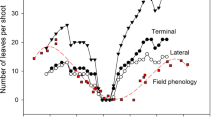Abstract
Effects of growth temperature and winter duration on leaf longevity were compared between a spring ephemeral, Gagea lutea, and a forest summergreen forb, Maianthemum dilatatum. The plants were grown at day/night temperatures of 25/20°C and 15/10°C after a chilling treatment for variable periods at 2°C. The temperature regime of 25/20°C was much higher than the mean air temperatures for both species in their native habitats. Warm temperature of 25/20°C and/or long chilling treatment shortened leaf longevity in G. lutea, but not in M. dilatatum. The response of G. lutea was consistent with that reported for other spring ephemerals. Air temperature increases as the vegetative season progresses. The decrease in leaf longevity in G. lutea under warm temperature condition ensures leaf senescence in summer, an unfavorable season for its growth. This also implies that early leaf senescence could occur in years with early summers. Warm spring temperatures have been shown to accelerate the leafing-out of forest trees. The decrease in leaf longevity due to warm temperature helps synchronize the period of leaf senescence roughly with the time of the forest canopy leaf-out. Prolonged winter due to late snowmelt has been shown to shorten the vegetative period for spring ephemerals. The decrease in leaf longevity due to long chilling treatment would correspond with this shortened vegetative period.


Similar content being viewed by others
References
Badri MA, Minchin PEH, Lapointe L (2007) Effects of temperature on the growth of spring ephemerals: Crocus vernus. Physiol Plant 130:67–76
Caldwell MLH (1969) Erythronium: comparative phenology of alpine and deciduous forest species in relation to environment. Am Midl Nat 82:543–558
Cannell MGR, Smith RI (1986) Climatic warming, spring budburst and frost damage on trees. J Appl Ecol 23:177–191
De Hertogh A, Zimmer K (1993) Allium-Ornamental species. In: De Hertogh A, Le Nard M (eds) The physiology of flower bulbs. Elsevier, Amsterdam, pp 187–200
Dennett MD, Auld BA (1980) The effects of position and temperature on the expansion of leaves of Vicia faba L. Ann Bot 46:511–517
Fukuda T (1987) The phenology and growth characteristics of Erythronium japonicum Decne. (Liliaceae). J Phytogeogr Taxon 35:36–41
Hamerlynck EP, Smith WK (1994) Subnivean and emergent microclimate, photosynthesis, and growth in Erythronium grandiflorum, a snowbank geophyte. Arct Alp Res 26:21–28
Hunter AF, Lechowicz MJ (1992) Predicting the timing of budburst in temperate trees. J Appl Ecol 29:597–604
Kawano S, Nishikawa Y (2004) Gagea lutea (l.) Ker-Gaul (in Japanese with English summary). In: Kawano S (ed) Life history monograph of Japanese plants, vol I, Spring plants No. 1
Kawano S, Ihara M, Suzuki M (1968) Biosystematic studies on Maianthemum (Liliaceae-Polygonatae) II. Geography and ecological life history. Jpn J Bot 20:35–65
Kawano S, Takasu H, Nagai Y (1978) The productive and reproductive biology of flowering plants. IV. Assimilation behavior of some temperate woodland plants. J Coll Lib Arts Toyama Univ 11:33–60
Kawano S, Masuda J, Takasu H (1982) The productive and reproductive biology of flowering plants. IX. Further studies on the assimilation behavior of temperate woodland herbs. J Coll Lib Arts Toyama Univ 15:101–160
Kikuzawa K (2005) Ecology of leaf longevity (in Japanese). Kyouritsu Shuppan, Tokyo
Koyama H, Kawano S (1973) Biosystematic studies on Maianthemum (Liliaceae-Polygonatae). VII. Photosynthetic behaviour of M. dilatatum under changing temperate woodland environments and biological implications. Bot Mag Tokyo 86:89–101
Lapointe L (2001) How phenology influencesphysiology in deciduous forest spring ephemerals. Physiol Plant 113:151–157
Lapointe L, Lerat S (2006) Annual growth of the spring ephemeral Erythronium americanum as a function of temperature and Mycorrhizal status. Can J Bot 84:39–48
Mahall BE, Bormann FH (1978) A quantitative description of the vegetative phenology of herbs in a northern hardwood forest. Bot Gaz 139:467–481
Menzel A (2000) Trends in phonological phases in Europe between 1951 and 1996. Int J Biometeorol 44:76–81
Muller RN (1978) The phenology, growth and ecosystem dynamics of Erythronium americanum in the northern hardwood forest. Ecol Monogr 48:1–20
Murray MB, Cannell MGR, Smith RI (1989) Date of budburst of fifteen tree species in Britain following climatic warming. J Appl Ecol 26:693–700
Nault A, Gagnon D (1988) Seasonal biomass and nutrient allocation patterns in wild leek (Allium tricoccum ait.), a spring geophyte. Bull Torrey Bot Club 115:45–54
Nault A, Gagnon D (1993) Ramet demography of Allium tricoccum, a spring ephemeral, perennial forest herb. J Ecol 81:101–119
Peñuelas J, Filella I, Comas P (2002) Changed plant and animal life cycles from 1952 to 2000 in the Mediterranean region. Glob Chang Biol 8:531–544
Raulier F, Bernier PY (2000) Predicting the date of leaf emergence for sugar maple across its native range. Can J For Res 30:1429–1435
Rawson HM, Hindmarsh JH (1982) Effects of temperature on leaf expansion in sunflower. Aust J Plant Physiol 9:209–219
Rees AR (1972) The growth of bulbs. Academic Press, London
Risser P, Cottam G (1967) Influence of temperature on the dormancy of some spring ephemerals. Ecology 48:500–503
Satake Y (1982) Liliaceae. In: Satake Y, Ohwi J, Kitamura S, Watari S, Tominari T (eds) Wild flowers of Japan. Herbaceous plants (including dwarf subshurubs). Heibonsha, Tokyo
Sawada S, Chida A, Sawaguchi Y, Nagasawa N (1997) Dry matter production, population structure and Environmental conditions of the spring ephemeral Erythronium japonicum growing in various habitats differing in sunlight exposure in cool temperate Japan. Ecol Res 12:89–99
Sparling JH (1967) Assimilation rates of some woodland herbs in Ontario. Botanical Gazette 128:160–168
Taylor RJ, Pearcy RW (1976) Seasonal patterns of the CO2 exchange characteristics of understory plants from a deciduous forest. Can J Bot 54:1094–1103
Vézina PE, Grandtner MM (1965) Phenological observations of spring geophytes in Quebec. Ecology 46:869–872
Yoshie F (2006) Effect of low temperatures on leaf fall of Fagus crenata seedlings (in Japanese with English summary). Bull Inst Nat Sci Senshu Univ 37:27–30
Yoshie F (2008) Dormancy of alpine and subalpine perennial forbs. Ecol Res 23:35–40
Yoshie F, Fukuda T (1994) Effects of growth temperature and winter duration on leaf phenology of Erythronium japonicum, a forest spring geophyte. Oecologia 97:366–368
Yoshie F, Yoshida S (1989) Wintering forms of perennial herbs in the cool temperate region of Japan. Can J Bot 67:3563–3569
Zimmer K, Walingen M, Gebauer B (1985) Untersuchungen an Allium christophii. Dtsch Gart 39:2206–2209
Acknowledgments
I thank Dr. L. Lapointe for many invaluable comments on the manuscript. I also thank the staff of Tomakomai Experimental Forests of Hokkaido University for granting permission for sample collection.
Author information
Authors and Affiliations
Corresponding author
Rights and permissions
About this article
Cite this article
Yoshie, F. Effects of growth temperature and winter duration on leaf phenology of a spring ephemeral (Gagea lutea) and a summergreen forb (Maianthemum dilatatum). J Plant Res 121, 483–492 (2008). https://doi.org/10.1007/s10265-008-0173-9
Received:
Accepted:
Published:
Issue Date:
DOI: https://doi.org/10.1007/s10265-008-0173-9




